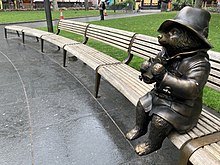
Back الدب بادينغتون Arabic Osu Paddington AST Paddinqton Ayısı Azerbaijani Мядзьведзяня Падынгтан BE-X-OLD Мечето Падингтън Bulgarian Os Paddington Catalan Paddington Bear Welsh Bjørnen Paddington Danish Paddington Bär German Urso Paddington Esperanto
| Paddington Bear | |
|---|---|
| Paddington character | |
 Statue of Paddington eating a sandwich in Leicester Square, London | |
| First appearance |
|
| Created by | Michael Bond |
| In-universe information | |
| Alias | Paddington |
| Species | Spectacled bear |
| Gender | Male |
| Family |
|
| Origin | Peru |
| Nationality | |
Paddington Bear (though his name is just Paddington; the "Bear" simply serves to confirm his species) is a fictional character in British children's literature. He first appeared on 13 October 1958 in the children's book A Bear Called Paddington by British author Michael Bond. He has featured in twenty nine books written by Bond, the last of which, Paddington at St. Paul's, was published posthumously in 2018.[1][2] The books have been illustrated by Peggy Fortnum, David McKee, R. W. Alley, and other artists.[3]
The friendly, anthropomorphised spectacled bear from "darkest Peru"—with his old hat, battered suitcase, duffel coat and love of marmalade sandwiches—has become a classic character in British children's literature.[4] Paddington is always polite—addressing people as "Mr", "Mrs", and "Miss", but rarely by first names—and kindhearted, though he inflicts hard stares on those who incur his disapproval.[5] He has an endless capacity for innocently getting into trouble, but is known to "try so hard to get things right". After being discovered in London Paddington station by the Brown family, he was adopted and named "Paddington Brown", as his original name in bear language was too hard for the (human) Browns to pronounce.
Paddington has become one of the most beloved British fictional characters—a Paddington Bear stuffed toy was chosen by British tunnellers as the first item to pass through to their French counterparts when the two sides of the Channel Tunnel were linked in 1994, and the Bear appeared with Queen Elizabeth II in a pre-recorded comedy segment for the Platinum Party at the Palace in 2022—and the Paddington books have been translated into 30 languages across 70 titles, with a total of more than 30 million copies sold worldwide.[6] As of June 2016, the Paddington Bear franchise was owned by Canal+'s StudioCanal, though Bond continued to own the publishing rights to his series, which was licensed to HarperCollins in April 2017.[7]
Since its first appearance on the BBC in 1976, Paddington Bear has been adapted for television, films, and commercials. Television adaptations include Paddington, broadcast from 1976 to 1980. The critically acclaimed and commercially successful films Paddington (2014) and Paddington 2 (2017) were both nominated for the BAFTA Award for Outstanding British Film. A third film in the series, Paddington in Peru, was released in cinemas in the United Kingdom on 8 November 2024.[8]
- ^ "Hard stares, tea with the Queen and so many marmalade sandwiches – 65 years of Paddington Bear". The Guardian. Retrieved 23 September 2024.
- ^ Cite error: The named reference
Last storywas invoked but never defined (see the help page). - ^ "About". Paddington.com. Archived from the original on 17 August 2016.
- ^ "Happy birthday little bear – Sunderland Echo, 26 June 2008". Archived from the original on 27 January 2009. Retrieved 26 June 2008.
- ^ "Michael Bond: 'Paddington stands up for things, he's, not afraid of going to the top and giving them a hard stare'". The Guardian. Retrieved 10 September 2019.
- ^ "Paddington Bear: 13 things you didn't know". The Telegraph. 4 October 2016. Archived from the original on 12 January 2022.
- ^ "HarperCollins secures six-year publishing partnership for Paddington". Archived from the original on 11 July 2017. Retrieved 10 April 2017.
- ^ Paddington in Peru (2024) – Release info – IMDb. Retrieved 17 December 2024 – via www.imdb.com.